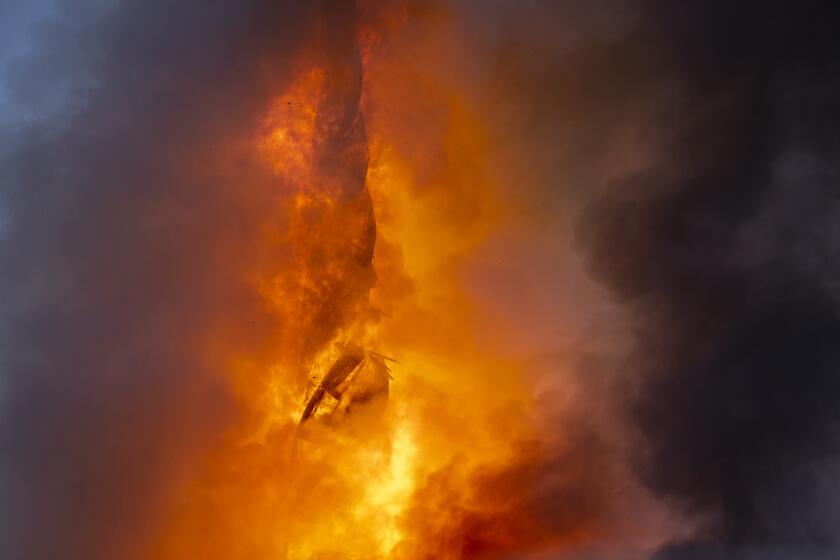Texas A&M; updates a cadet tradition
They can be seen marching into the stadium at the start of Texas A&M home football games, knee-high riding boots gleaming, swords tucked at their waists.
They form two lines to channel the rushing football players onto the field. But the Corps of Cadets is more than a color guard, a uniformed patch in the Aggie crowd known as “The Twelfth Man.”
The Corps is a way of life for about 2,200 students and 40,000 alumni, including many Texas luminaries, such as U.S. Rep. Joe Barton, actor Rip Torn, astronaut Michael Fossum and Gov. Rick Perry.
The system, which refined generations of self-described good ol’ boys into military and political leaders, is now turning out a very different kind of cadet.
Shahrum Iqbal, 22, an electrical engineering major from Karachi, Pakistan, joined the Corps as a freshman.
“Coming here, I had a huge language barrier, cultural barrier, physical barrier to cross,” said the senior, looking sharp in his crew cut and full uniform. “The Corps got me over that.”
Corps leaders, who have drawn criticism in the past along with other military academies for failing to diversify, are taking cues from military recruiters, reaching out to minorities—including gays— and emphasizing diversity as the key to the institution’s survival.
“Diversity gives us strength. Our Corps does not reflect that right now to the degree that I would like,” said retired Army Brigadier Gen. Joe Ramirez, a former cadet now leading the Corps as commandant.
Ramirez traveled to inner-city schools statewide to recruit 300 new cadets since he started last year. He notes that the university is about 47% female, 5% Asian and 3% black, while the Corps is about 12% female, 4% Asian and 2% black. Both the university and the Corps are about 15% Latino.
Last year, minority cadets started the Cultural Awareness and Diversity Expansion Team to promote diversity within the Corps, and Ramirez helped them hold a series of seminars to talk to fellow cadets about diversity and “where we’re trying to go as a university and the Corps.”
Ramirez has updated Corps recruiting and advertising materials to make them bilingual and show more minority and female cadets. Alumni have noticed.
“It’s very important that women and minorities be shown in any kind of advertising for the Corps so it just becomes an assumption that they can be in the Corps,” said Roxie Pranglin, 55, who was among the first women to join the Corps. “That is an untapped resource.”
Membership in the Corps was compulsory when the Agricultural and Mechanical College of Texas was founded as a public military academy in 1876, but became optional in 1965, about two years after the university started integrating and admitting women.
Texas A&M has mushroomed to nearly 50,000 students, but many Corps traditions still hold. Cadets room in the same dorms, wear the same uniforms to class, speak the same military-infused jargon. Cadets caring for Reveille, the school’s mascot collie, must address her as “Miss Rev, ma’am.”
Inside the hushed Corps museum, or Hall of Honor, 22-year-old Aneesa Castaneda described the Corps’ emphasis on work and merit. Castaneda, a construction science major who has already contracted with the Army, said female cadets must earn the right to wear slacks instead of skirts, their hair up in buns instead of French braids.
“You have to earn your place here,” she said, her own dark hair tucked into a neat bun. “You end up learning how to be humble.”
Women and minorities had to do more than satisfy the rules to earn their place in the Corps. Some traditionalist cadets feared the Corps would be overwhelmed by changes sweeping the university in the 1960s.
Women, who were admitted to the Corps in 1974, were segregated in a special unit and derisively dubbed “Waggies.” They were banned from leadership positions and elite Corps units such as the Ross Volunteers, who serve as the governor’s honor guard, and the Aggie Band. During their senior year, they were not allowed to wear boots like the men.
“No one really knew how to work with us or what to do,” Pranglin said.
While most new cadets back then faced hazing, the women were singled out not only by what Pranglin called a “vocal minority” of cadets, but also by cadets’ girlfriends and other female students. Manure and animal parts were sometimes tossed through their dorm windows.
“I learned pretty quick to keep my window shut and locked,” Pranglin said, adding, “I value and treasure even more today those who were willing to befriend us and support us and stand up for us.”
A federal lawsuit by a female cadet eventually compelled the Corps to open its elite groups to women in 1988. Two years later, the Corps eliminated female-only units. “After that,” Pranglin said, “”Women began getting a fair shake.”
Meanwhile, since cadets had to enroll in ROTC their first two years, any evidence they were gay was grounds for dismissal from the Corps. That changed with the overturning of “don’t ask, don’t tell” this fall, which Ramirez called “the right thing to do.”
“I’m trying to increase or promote diversity in the Corps so we better reflect our state and nation,” including gays, he said.
Such path-breaking, ultimately, helped Iqbal rise to second in command of the Corps. Iqbal recalls that as a sophomore, he was asked lots of questions about his homeland, his faith (he is Muslim) and why he joined the Corps.
Over time, he said, he began to blend into the ranks. “That’s what the Corps helps—to get to know people and break stereotypes,” he said.
Now no one blinks an eye when they see Iqbal at football games, up in the president’s box in his dress uniform, or “midnights.”
“They consider me more of the norm,” he said. “In the Corps culture, I’ve assimilated.”
molly.hennessy-fiske@latimes.com
Rick Rojas contributed reporting in Los Angeles.
More to Read
Start your day right
Sign up for Essential California for news, features and recommendations from the L.A. Times and beyond in your inbox six days a week.
You may occasionally receive promotional content from the Los Angeles Times.







